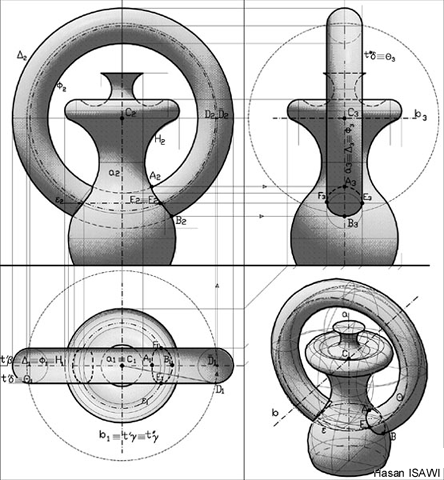If you’ve ever found technical drawings useful, particularly those with 3-D projections, raise a glass and toast the anniversary of the birth of Gaspard Monge. He was born May 9, 1746 in France, and invented those things, as well as differential geometry (which you could use to describe the surface of that glass you’re raising).
Monge was born into what was a “middle class” family for the time; his father was a merchant. He was recognized as pretty bright right away, and in fact when he attended college (starting at 16), the faculty threw their hands up after just one year and named him the professor of physics. He was all of 17.
After college he returned to his home town of Beaune, and apparently just for fun created a large-scale technical illustration of the town. In the process, he invented new methods of observation and new drawing instruments. You can still see his work, by the way; it’s in the town library. It was the talk of the town for some time, and one of the people who saw it was an officer of a military engineering group. He wrote to the Royal School of Engineering, which hired Monge on the spot. While there he earned his reputation as the creator of engineering drawing.
One issue at the Royal School, though, was that only members of the French Aristocracy were allowed to be official students or faculty. As a “commoner,” Monge was allowed to be an employee, but not a student or teacher. They admired his illustrations, but when he pointed out that he provided them with mathematical justification that he’d also invented, they weren’t interested. This evidently left Monge with a bad feeling about royalty and its trappings, and when the French Revolution came along in 1789, he was a strong supporter. He was named the Minister of the Marine in the revolutionary government, and also became very active in updating educational curricula in France. He became a professor of descriptive geometry at several colleges — this was probably helped by the fact that he’d invented descriptive geometry. He also published a number of textbooks. But when the government encouraged him to write a more complete textbook covering all of math, he declined for an interesting reason. One of his old mentors, who had passed away had written the text then in use. Monge argued that if he wrote a textbook that supplanted the existing one, his mentor’s widow would lose her only source of income, which was from the textbook sales.
In addition to his contributions to math and geometry, Monge did some work in experimental science as well, and published papers about engineering and what today would be called “materials science.” There are quite a few mathematical objects that still bear his name, including the Monge array, the Monge cone, and the Monge point, and he was also the first to rigorously study transportation theory and resource allocation. He also published an early text about statistics.
There are 72 names of scientists, mathematicians, and engineers inscribed on the base of the Eiffel Tower in Paris. Monge is one of them. And there’s a ship in the French Navy named the MRIS Monge. Not to mention all the engineering drawings that have followed his example.

Intersection of Solids By Hasan Isawi https://isawi.blogspot.com/2023/01/final-digital-exam-intersection-of.html – Own work, CC BY-SA 3.0, https://commons.wikimedia.org/w/index.php?curid=2859643

Leave a Reply